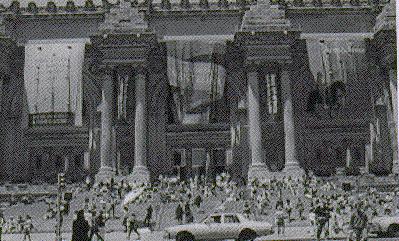|
Renaissance Paintings at the Met
1000 Fifth Avenue
New York 10028

History of the Met
How it All Began:
In 1866, a small group of Americans were celebrating
the Fourth of July in Paris. One evening after dinner, John Jay,
the grandson of the famous judge, gave a speech and suggested
that the group create an art museum. Everyone thought that it
was a great suggestion and the idea for The Metropolitan Museum
of Art was born. In 1870, the museum acquired its first object:
the unfurnished Garland sarcophagus that dates from about A.D.
200-225. This art piece is presently located tucked away to the
left of the door when entering the museum.
Shortly after that, a collection of one hundred and
seventy four old master paintings were purchased in Europe for
the museum. The collection was first housed in the Dodworth building
at 681 Fifth avenue, and then at 128 West Fourteenth street. As
the collection grew, more space was needed. On March 30, 1880,
the museum moved to its current location.
The Met Today:
The Metropolitan Museum of Art is by far one of the
most fascinating museums in the world. Located in the heart of
mid-Manhattan, the Met contains collections including more than
two million works of art. These collection include some of the
following:
- The American Wing
- Ancient Near Eastern Art
- Arms and Armor
- Arts of Africa, Oceania, and the Americans
- Asian Art
- Chinese Art
- Costume Institute
- Drawings, Prints, and Photographs
- Egyptian Art
- European Paintings
- European Sculpture and Decorative Arts
- South and SouthEast Asian Art
- Greek and Roman Art
- Islamic Art
- Japanese Art
- The Robert Lehman Collection
- Musical Instruments
- Medieval Art
- Nineteenth-Century European Paintings
- 20th Century Art
Many of these collections are on view at any given
moment. All of which include more than 5,000 years of world culture,
from prehistory to the present. Often, in celebration of a artist
or era of art, the museum will focus on separate exhibitions.
Exhibitions that exonerate the artist through ambitious programs
of concerts, lectures, films, and other public programs.
[*This information has been provided by The Metropolitan Museum
of Art.]
Early Renaissance Paintings
Early Renaissance paintings did not appear until
the Early 1420's. The new style that came about through early
Renaissance paintings was launched single handily by a young genius
named Masaccio (1401-1428), who was only 21 years old at the time.
By then, the early Renaissance was well established in sculpture
and architecture.
Early Renaissance Italian Paintings reflect changes
of the people within communities at the time. Paintings of this
time were mostly symbolic representations of religious figures
and icons. Some paintings pictured scenes from the Bible such
as: "The Holy Trinity", "The Madonna Enthroned",
and "The Last Supper". Other Paintings represented during
this time were of struggles amoung the classes of people, such
as "The Battle of San Romano", by Paolo Uccello, which
depicted a bloody battle between two armies.
Further in time, the founders of Early Italian Renaissance
paintings disappeared one by one in the middle years of the century,
a younger generation began to assert itself. At the same time,
the seeds planted by Florentine masters were beginning to flower.
[* This Information has been provide by the History
of Art Encyclopedia.]
Experiencing The Met
First Arrival:
When arriving at The Metropolitan Museum of Art one
is greeted immediately by the friendly receptionists at the information
desks. Information desks are located in the center of the ground
floor and any questions regarding location of exhibits or specific
collections are answered.
Other Attractions:
Besides exhibitions the museum provides visitors
with dinning facilities for those who enjoy eating. Also, concerts
and lectures are given providing specific information are certain
exhibits. Furthermore, libraries and study rooms are readily available
for those who enjoy researching exhibited works. To top it off,
the museum has gift shops that contain all sorts of wonderful
artistic objects. Mugs with Degas paintings, ties with Dali figures
represented on them, and small replicas of MichelAngelo paintings
in poster form or canvas, also much more.
Italian Renaissance Paintings:
Early Italian renaissance paintings are found on
the second floor of the museum. The immediate vibe one senses
when entering the exhibition is of immense impression. The feeling
of the Medieval World of Art is expressed through the diversity
of the artists as well as their creativity. Beauty, magnificence,
and talent is all expressed in one creation. I strongly suggest
that this experience be visualized by each and everyone one of
you. The met is the place to be!
Back to Medieval New York Page
A Web Site Project by Jennifer Perez
This Project has been developed for The Introduction to Medieval History Course.
Available at Fordham University and instructed by Professor: Paul
Halsall.
For further information contact the Fordham University Home Page.
The Internet History Sourcebooks Project is located at the History Department of Fordham University, New York. The Internet
Medieval Sourcebook, and other medieval components of the project, are located at
the Fordham University Center
for Medieval Studies.The IHSP recognizes the contribution of Fordham University, the
Fordham University History Department, and the Fordham Center for Medieval Studies in
providing web space and server support for the project. The IHSP is a project independent of Fordham University. Although the IHSP seeks to follow all applicable copyright law, Fordham University is not
the institutional owner, and is not liable as the result of any legal action.
© Site Concept and Design: Paul Halsall created 26 Jan 1996: latest revision 12 April 2024 [CV]
|